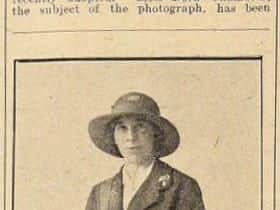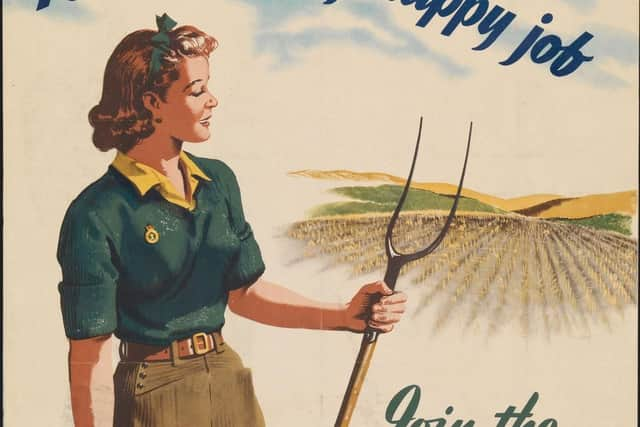Heritage looks back at: The same passion for fashion a century ago in Doncaster


Local history volunteer Lynda Regan has been scouring the archives to discover what life was like in wartime Doncaster, before the Peace Treaty was finally signed in June 1919 – part of her work for Doncaster 1914-18, a community heritage project supported by National Lottery Players through the National Lottery Heritage Fund.
Lynda’s found that Doncaster’s dress sense can provide a fascinating glimpse into what was on people’s minds during the war years, reflecting how people – then and now – are ‘shaped’ and fashioned by the world around us.


Advertisement
Hide AdAdvertisement
Hide AdTrends in jewellery, for example, reveal how people’s lives changed during the war. Sentimental ‘sweetheart jewellery’ became very popular, with original photographs illustrating how keepsakes given by soldiers were proudly worn by women at home, especially regimental badges worn as brooches. Meanwhile, local newspapers of the time also carried an extraordinary number of advertisements for wedding and engagement rings, as many couples hurried to get married before the groom’s call-up.
In the early 20th century, the way most people shopped for clothes was similar to today, with ‘high street’ fashion becoming much more commonplace; but even at the height of the war, the appetite for fashion never seemed to wane in Doncaster. Local newspapers advertised new stock arrivals and the January Sales, as popular then as now, in the town’s top stores like Gamman on the High Street, Dennis Roberts & Sons on St. Sepulchre Gate, Stewarts on Baxter Gate or Walsh’s Hats and Blouses.
What’s more, an international fashion icon was born in the area during the war years: Thomas Burberry of Castleford developed a new raincoat for the UK War Office at the turn of the century. It was created for Officers – lower ranks weren’t permitted to wear them – with a smart double-breasted design, buttoned pockets, belted at the waist, and made of waterproof gabardine with an insulated lining. During the First World War, it was a godsend for soldiers in the trenches, who fondly re-named it the Trenchcoat, and it was during on the frontline that it gained its distinctive shoulder straps and D-rings to attach rank insignia, and hold swords and map cases. Veterans kept their beloved Trenchcoats when they returned to civilian life, and the fashion caught on among both men and women – and is still very much in vogue today.
Women’s increasing independence during the First World War, leading to the momentous decision to give women the right to vote in 1918, also seemed to spark a fascination with appearances. By going out to work for the first time in support of the war effort, many women seemed to feel as though they were able – perhaps for the first time – to shape not only their destiny, but the fate of their nation, growing in confidence and assertiveness. Advertisements and letters published in newspapers reveal that many women were exploring what should they look like in this new world, a dilemma that seems very modern: how could women show that they were strong, courageous and responsible ‘soldiers of the home front’, but also hold onto their femininity when they were doing hard manual labour usually reserved for men, often while wearing functional ‘men’s clothing’?


Advertisement
Hide AdAdvertisement
Hide AdAs a result, make-up – face powder, eyeliner and mascara – started to become much more acceptable, with cosmetic firms like Helena Rubinstein, Elizabeth Arden and Maybelline established in 1915. There was growing demand for face creams, especially from wealthier women who were volunteering as nurses at the front, working in much harsher conditions than they’d ever experience at home. Meanwhile, Gillette introduced a razor suitable for women during those war years, and in 1917, the opticians Bell Brothers of St. Sepulchre Gate advertised their new Rimless Glasses describing them as “essentially dainty and therefore suitable to the Fair Sex”. As women’s lives changed, so did their hemlines. At the start of the war as women began to support the war effort, hemlines rose to mid-calf, showing off boots and shoes and a well-darned stocking. Women also began to wear less underwear, rejecting unwieldy layers of petticoats, although keeping their corsets. By 1918, the hemline had soberly fallen back to below-calf, and skirts became narrower.
Perhaps the biggest change to hemlines was that many women got to ‘wear the trousers’ for the first time in Britain during the First World War, in heavy industries like mining, munitions, engineering, farming, also on the railways and road transport. Although trousers were worn as a necessity for both safety and modesty, their introduction initially caused shock and disapproval, and many women disliked them as too hot to work in and made of bulky material. Within just a few years, however, many women began to wear their trousers proudly – refashioning them into a symbol of liberation and emancipation.
To find out more about First World War fashion in Doncaster, or to share stories and photographs about your family’s or neighbourhood’s wartime history, please visit www.doncaster1914-18.org.uk – a free online archive free for everyone to use.